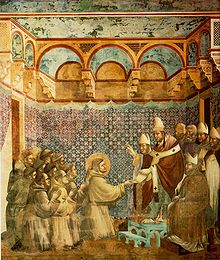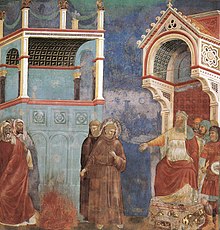Pietro Catanii
Pietro Catanii , also Pietro Cattani, Pietro di Cattanio or Latinized Petrus Catani (* before 1180 in Assisi ; † March 10, 1221 in Assisi) was an early companion of St. Francis of Assisi . He witnessed the early expansion of the Order of the Friars Minor and was one of the saint's closest confidants. He later took over the leadership of the order from Francis, but died during his lifetime.
origin
Pietro Catanii was a man from the noble, possibly noble family of the Catanii in Assisi. He was educated and a lawyer by profession. His date of birth is not known, but he was probably about the same age as Francis (* 1181 or 1182) or a little older. Pietro Catanii was probably also a priest, although the sources are not clear here. Older biographies do not mention it, but in more recent sources such as the Speculum perfectionis (written around 1318) it is reported that he was a canon or a member of the cathedral chapter of San Rufino in Assisi .
Connection to Francis

According to the biographers, Pietro Catanii and Bernhard von Quintavalle came to Francis on April 16, 1208. Both gave away all their possessions to the poor , imitating Francis, who in turn imitated the life of the apostles . According to the tradition of the Three Companions , the three brothers considered the rule of the order to be the three sentences that they had determined from the Gospels by lot:
- “If you want to be perfect, go sell your property and give the money to the poor; so you will have an abiding treasure in heaven; then come and follow me. ” (Mt 19:21)
- "Take nothing with you on the way, no walking stick and no storage bag, no bread, no money and no second shirt." (Lk 9.3)
- "Whoever wants to be my disciple, deny himself, take up his cross daily and follow me." (Lk 9:23)
A week later, the three brothers also joined Aegidius, a farmer from Assisi. In the following time the two brothers traveled through Italy as penitential preachers , Pietro with Bernhard, Francis with Aegidius. They begged for a living. They preached repentance and repentance. In the following time, other men joined them.
Brother Pietro was also among the first twelve brothers who went to Rome in 1209 to get their original rule from Pope Innocent III. to be confirmed.
Pietro Catanii was taken to the Orient by Francis in 1219/20 and was present at the Damiette crusade and at the sermon before the Sultan . In other sources, however, Brother Illuminatus of Arce is mentioned as a companion. Francis and Pietro Catanii treated each other in a chivalrously polite manner and addressed each other as "Lord". This shows the mutual respect that bound them.
Head of the newly established order
Francis presumably resigned from the leadership of the order at the chapter of the order on September 29, 1220 and installed Pietro as "general minister" (the titles of the offices were not yet determined at that time). Rosalind B. Brooke, on the other hand, is of the opinion that he was installed much earlier, at the Pentecost chapter on May 14, 1217, as vicar (i.e. as deputy ). There is much to be said for it, for example the many undated episodes in the legends in which he is mentioned as vicar, but which in the short time from 1220 until his death had hardly any space. Celano states that a few years after his conversion , Francis handed over the leadership of the order to Brother Pietro and solemnly vowed obedience to him, seeing him as general minister and not as vicar. Nevertheless, Francis continued to lead the order in important points according to his own opinion and also took Petrus Catanii into obedience here. It is also possible that Pietro, in his modesty, accepted the leadership of the order, but did not demand obedience from Francis himself. In the official census, Pietro Catanii is not counted as Minister General , the census only starts after the death of Francis.
death
Pietro Catanii died on March 10, 1221 and was buried near the Portiuncula Church. His tombstone is built into the south wall of the church. The inscription is still legible today. According to legend, miracles happened after the death of his brother Pietro ; There were also pilgrims came to Portiuncula, Francis to the dead, had been praying for a cessation of miracles because of the unrest that brought the with them. Apparently, however, these miracles were never confirmed; in any case, Pietro was never canonized , which would have been likely with confirmed miracles.
literature
- Thomas von Celano: Life and Miracles of St. Francis of Assisi . Butzon & Bercker, Kevelaer 2001, ISBN 3-7666-2014-2 .
- Helmut Feld: Francis of Assisi and his movement . Primus-Verlag, Darmstadt 1996, ISBN 3-89678-001-8 .
Web links
Footnotes
- ^ Jordan von Giano, Chronica 11.
- ↑ Helmut Feld speculates in "Francis of Assisi and his Movement", Wissenschaftliche Buchgesellschaft Darmstadt 1994, that Catanii may not have been the cathedral chapter directly, but that he was a legal advisor or lawyer for the cathedral chapter. This would explain his proximity to Bernhard von Quintavalle who was legal advisor to the city government in Assisi.
- ↑ Thomas von Celano: Life and Miracles of St. Francis of Assisi . Butzon & Bercker, Kevelaer 2001, ISBN 3-7666-2014-2
- ^ Jordan from Giano Chronica 11.
- ↑ quoted from Helmut Feld: Franziskus von Assisi and his movement . Primus-Verlag, Darmstadt 1996, ISBN 3-89678-001-8
- ↑ Thomas von Celano: The life and miracles of St. Francis 1228/29.
- ^ Bartholomew of Pisa: De conformitate vitae beati Francisci ad vitam Domini Jesu, 1385-90.
| personal data | |
|---|---|
| SURNAME | Catanii, Pietro |
| ALTERNATIVE NAMES | Cattani, Pietro; Catanii, Peter |
| BRIEF DESCRIPTION | Companion of Francis of Assisi |
| DATE OF BIRTH | 12th Century |
| PLACE OF BIRTH | Assisi |
| DATE OF DEATH | March 10, 1221 |
| Place of death | Assisi |
